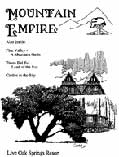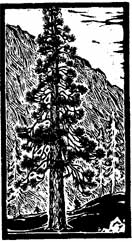|
Pine Valley - A Mountain Oasis
By Todd Gilbert
Nestled in a valley surrounded by rolling hills and towering peaks reaching 6,000 feet . . . rocky knolls amidst a river of trees that flow through the valley and greet the slopes of the adjacent mountains . . . an Eden amidst the dry, parched chaparral . . . an oasis dense with pines, manzanita and centuries old oak trees that once shaded only the Indians that inhabited the region: "El Valle de los Pinos", as this beautiful mountain valley was known before 1869, describes the abrupt change in scenery that only nature can explain. The surrounding desert terrain compliments the unique valley of over 1,200 acres where cedars and pines flourish amidst lush green meadows of sage and wild lilac.
Early settlers of the region included the Cocopah and Coyote Indians and later the Machados family of Old Town who had come to California as pioneers in the late 18th century. For a number of years, Don Manuel Machado and his wife, Serafina Valdes operated a cattle grazing station and lived out of a Adobe house they had built. During the summer, thin and starved longhorn cattle were brought in to fatten up in the rich pastureland.
In 1869, former Butterfield Stage coach driver, Captain William S. Emery and his wife settled in the area. Being Scotch-English pioneers from New England, the sound of Spanish words were unpleasant to their ears and, quickly, renamed "El Valle de los Pinos" to its literal translation of Pine Valley. Either way, the valley boasts one of the oldest names in the county.
Charles F. Emery, son of Captain Emery, used to tell the story of his father's experiences on the old desert stage route and in dealing with the local Cocopah and Coyote Indians who were constantly running off the cattle he had accumulated. One old Indian, Antonio, told Captain Emery he could show him a beautiful valley in the mountains where there was plenty of grass for cattle where nobody else lived.
So the two came on horseback over the Vallecitos trail through Laguna and descended upon a beautiful valley where they found an old man splitting timber. The old man offered to sell his claim on the land for one horse. Captain Emery and John Ross, a Canadian working for him, soon built a log house (not far from the adobe that the Machados had occupied) and Emery quickly sent for his wife and children who sailed from San Francisco to San Diego.
A covered wagon and six mules were sent for Mrs. Emery and her children. As there was no direct route between San Diego and Pine Valley, they had to head south through Tijunana and east through Tecate and Campo, a route which, by the afternoon of the fourth day, put them in Pine Valley. The Emerys remained in Pine Valley and published a family newspaper. Their home became a gathering point for cattlemen in the neighborhood who came to hear music and listen to readings.
Another era of pioneering hit Pine Valley in 1870 when 12-year-old Charles Emery found a rock with the glimmer of quartz, known to often indicate the presence of gold. Gold fever in Pine Valley was ignited.
Although there is evidence that Spaniards had, long before, frequented the valley for its gold ore, it was not until word got out in 1870 that the area became a hot spot for mining. The Noble brothers from Ohio were the first to stake a claim in Pine Valley and hoped to find the other end of the rich Stonewall Mine located in Cuyamaca. The Stonewall Mine had proved to be an extremely profitable operation boasting several mine building, including a twenty-stamp mill, blacksmith and machine shops, a boiler room and a saw mill. However, the Nobles found only veins that averaged 1 1/2 inches thick and, to get at it, they had to remove large amounts of granite.
Most of their mines were not worth much. And, other than the Treasury mine which turned out to be quite successful, the Noble brothers made most of their profit by selling and reselling their mines. When a vein was found in a low-production mine, they would sell it to someone thirsty for instant riches. However, the gold would soon dry up and purchaser would be unable to pay off their debt, so the mine was repossessed and the Nobles started the process again.
Their profits, along with the abundance of water in Noble Canyon, enabled the Nobles to open a two-stamp water mill in 1889 which was later enlarged to a five-stamp water mill. The stamps were heavy pistons made of solid iron about six inches in diameter that were driven up and down by a crank shaft spindle which pounded the ore into dust. The dust was sent down a chute onto canvas sheets and then washed in water that removed the lighter worthless particles, but left behind the heavier pieces that often contained gold. The final process involved either sending the gold dust to smelter or placing it in a cyanide solution in order to isolate the cold from the other minerals.
Claims in Noble Canyon have been worked sporadically since the early 1900's by Noble Mines Inc. and small shipments of gold were recorded in 1938, 1940 and 1944. But it was not until the late 1960's that large-scale mining was again attempted.
With new machinery and techniques available, gold mining was, once again, profitable. Noble Mines Inc., which owns the claims, brought in Verne Harkness, an employee of Union Carbide in Washington who had had extensive mining experience. After a year of work and $33,000, the mines were ready to produce gold again.
The process offered little chance to "get rich quick". The ore was first heated to remove any moisture present. This made it easier to crush. After the ore was crushed into a fine powder, concentrates of gold and silver were separated in a flotation tank. The result of the process was not sackfuls of gold nuggets or silver, but rather five-gallon cans of blackish crystals which were then sent to smelting firms in Arizona. The five-gallon cans of ore, each weighing more than 300 pounds, would bring, at best, $3 a pound.
Harkness' refining mill handled close to 15 tons of ore a day which yielded anywhere from 10 to several thousand pounds of saleable minerals.
Harkness and two associates in the venture, Don Moore and Steve Reed worked eight claims in the mountains 4 1/2 miles north of Pine Valley, but concentrated on three mines - Treasury, Eureka and Bayview - which offered the most potential. A $250,000 yearly profit for Harkness and the Noble Creek Mines, Mill and Development Co. continued for several years.
One does not begin to be a resident of Pine Valley for very long without becoming aware of the threat of fire in the area. One of the darker episodes in pine Valley history occurred on the dates of September 26-30, 1970 when the Laguna-Kitchen Creek Fire consumed a total of 185,000 acres. The fire was first reported to the Fire Service at 6:15 a.m. on Saturday, September 26th. A helicopter responded to the report, but was forced to turn back because of high winds over the Pine Valley area. Emergency units were called in including fire retardant planes, but were withdrawn because the high wind rendered them non-effective. By noon, fire fighters established headquarters at the Pine Valley Improvement Clubhouse. Fire equipment, food, and fire fighters (including Navajo Indians) were ordered.
Control of the fire, without the cooperation of the elements was almost impossible. As the wind increased, the fire was burning at a rate of 4,000 acres per hour and traveled thirty-two miles in thirty hours. By the time the fire had been contained, a total of 185,000 acres, 388 homes, and 1,000 other structures, 23 vehicles and 800 miles of fencing were burned.
Old-timers report at least seven large fires in the area since 1928 including the Conejos Fire on August 16, 1950 which was not contained for six days and burned an estimated 44,000 acres. The scars of this fire can still be seen where it burned down the hill from Guatay to Pine Creek Road.
In spite of the obvious vulnerability of the valley to fire, the general feeling remains: "You don't leave something you love when it is threatened. You stay and fight. If there is damage, you repair; if your home is lost, you rebuild."
This connection between the people and the land is further evidenced by the abundance of horse stables and the extensive riding trails that stretch throughout the valley. Touring on horseback is an ideal way to meditate on the surroundings. Out on the trail, one hears only the sounds of pacing hoofs and the gurgling stream. The oaks and cedars and pines reach towards the sky making intricate patterns of light and shadow that shine on the rocks and glisten on the water while the sound of quail. Yet the occasional sound of the rush of the freeway reminds one of the busy world not far away.
The Pine Valley Bridge hangs in the distance 450 feet above the creek. The 34 million pound concrete segments that brought Interstate 8 past the town in 1974 are a marked contrast to the surroundings.
Many throughout the centuries have come to revere the valley's natural beauty and it has been speculated that perhaps it was once large lake. "As you look down you can see how the pines grow around what might well have been the old beach of such a lake," Charles Emery once said. It seems only fitting that the trees having grown in such a heavenly area were used in the building of the San Diego Mission.
As the heart of the Mountain Empire, Pine Valley remains a window to its past, every era having left its mark. The surrounding terrain remains as rugged as those who first settled in the area and the vistas remain as peaceful as the valley's way of life.

About the author:
Todd Gilbert, at the time of writing of this article, was attending San Diego State University studying journalism and photography.
|
|




